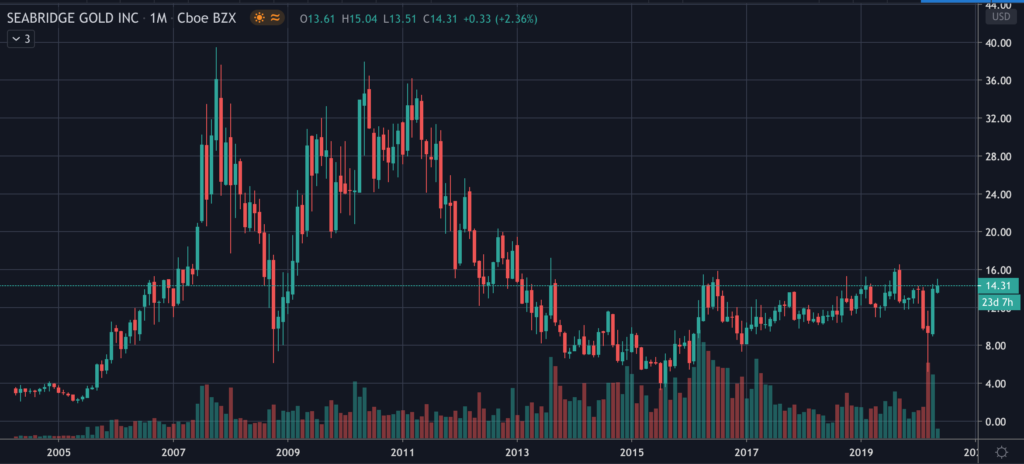Common Stock: Seabridge Gold (SA)
Current Market Price: $14.31 USD
Market Capitalization: $914 million USD

*Note: All amounts are in Canadian Dollars (CAD) unless otherwise stated.
Seabridge Gold – Summary of the Company
Seabridge Gold is a gold company focused on the exploration and acquisition of mining properties throughout the Americas. Their stated goal is to increase the amount of gold they own “in the ground” but not to go into production on their own. The company was founded in 1999 and is headquartered in Toronto, Canada.
Revenue and Cost Analysis
Seabridge Gold does not operate any producing mines, therefore they do not have any revenue. This means they consistently run a net loss, and will likely continue to do so.
In 2019 Seabridge had a net loss of $11.6 million. This was an improvement over 2018’s net loss of $20 million.
Most of the company’s expenses are classified as “corporate and administrative”. Compensation is the largest component of this expense. In 2019 cash compensation was $4.6 million, a 15% increase over the prior year. Stock based compensation was $5.4 million in 2019.
Balance Sheet Analysis
Seabridge Gold has a simple balance sheet. They have current assets of $19 million, including $8 million in cash. This is more than sufficient to meet their current obligations of $6 million.
They have long term liabilities of $27.6 million, most of which is a deferred tax liability. Almost all of the company’s $449 million in total assets are long term assets. The own $425 million in “mineral interests”
Seabridge has no debt. The have typically raised capital via equity financing, in 2019 they raised $20.4 million via a private placement, issuing 1.2 million shares at $17.02 per share.
Seabridge Gold Stock – Dividend
Seabridge Gold does not pay a dividend and is highly unlikely to pay one for the foreseeable future.
Seabridge Gold Stock – Share Dynamics and Capital Structure
As of March 2020, Seabridge Gold had 63,924,261 common shares outstanding. In addition, the company had options, RSUs and warrants outstanding, bringing the fully diluted shares outstanding to 67,536,544
Although the company does have some dilutive issues outstanding, these issues are not excessive. The capital structure appears to be acceptable for common stock holders. However, investors should consider that the company is highly reliant on equity financing and is likely to need to issue more shares in the future.
Management – Skin in the game
Over the last 12 months’ insiders at Seabridge Gold have been net sellers of the company’s stock. This is generally viewed as a bearish signal for the stock.
Seabridge Gold Stock – 3 Metrics to Consider
Working Capital Ratio
Current Assets/Current Liabilities
$19.2 million/$6.6 million= 2.8
A working capital ratio of 2.8 indicates sufficient balance sheet liquidity. The company shouldn’t have a problem meeting its short-term obligations.
Debt to Equity Ratio
Total Liabilities/Total Shareholder Equity
$27.6 million/$415 million = .06
Given the company’s very low liability levels, including no debt, they have a very low debt to equity ratio of .06. This means they have relied almost entirely on equity capital to finance the company.
Price to Book Ratio
Current price of common stock/ Book value per share
$14.31/$6.15= 2.3
Based on the estimate of fully diluted shares outstanding, Seabridge Gold has a book value per share of $6.15. At the current market price this implies a price to book ratio of 2.3. A price to book ratio of 2.3 means the common stock is currently trading at a premium to the book value of the company’s equity.
Gold Market – Economic Factors and Competitive Landscape
Gold mining is a highly competitive, capital intensive business. The company will need to compete fiercely for both new projects and capital. However, given the current economic environment of global money printing and zero or negative interest rates, it would appear gold companies are poised to benefit from a strong economic tailwind.
Seabridge Gold – Summary and Conclusions
Seabridge Gold has several good assets in the form of mineral interests. Their balance sheet is strong with low liability levels, no debt, and sufficient liquidity in the short term. However, the company runs a significant operating loss, most of which is due to compensation.
When Seabridge does eventually need to raise capital again, they will certainty issue more shares, diluting existing common stock holders. The biggest question for investors considering SA stock is whether they are willing to pay nearly $10 million per year for management to look after these “mineral interest” on their behalf. And, if they are willing to have their holdings diluted to finance the operation, while management increases their own compensation, takes bonuses, and sell their equity. Personally, I’m not willing to do so and will never be a buyer of SA stock.
Disclaimer
This is not investment advice. Nothing in this analysis should be construed as a recommendation to buy, sell, or otherwise take action related to the security discussed. If I own a position in the security discussed, I will clearly state it.
This is not intended to be a comprehensive analysis and you should not make an investment decision based solely on the information in this analysis. I hope this serves as a useful starting point for a more comprehensive analysis, and hopefully draws attention to aspects of the company that were overlooked or merit further investigation. This is by no means intended to be a complete analysis. Again, this is not investment advice, do your own research.